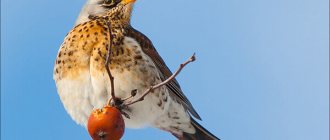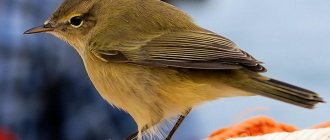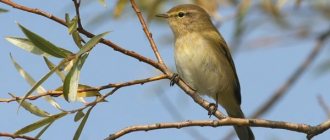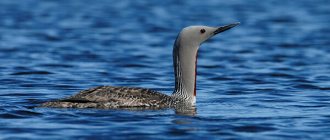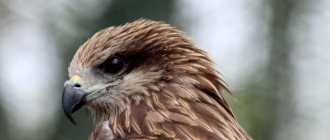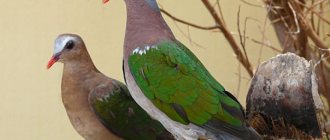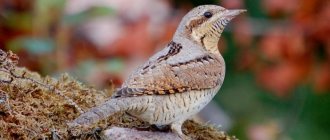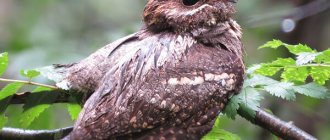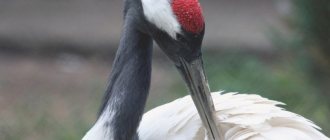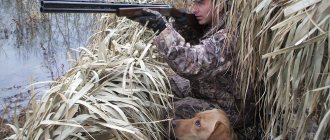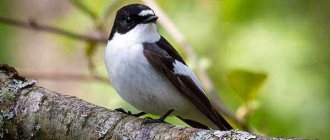White-browed thrushes are small songbirds belonging to the genus Thrushes, also called white-browed thrushes, white-browed thrushes or hazel thrushes.
The body length of the white-browed bird is approximately 22 centimeters, the weight of the bird is up to 60 grams. The color of the main plumage is brownish-greenish-olive.
On the lower part of the body the color of the thrush is lighter with dark olive spots. The chest part on the sides and the bottom of the coverts are rusty-red in color. The presence of white eyebrows above the eyes contributed to the name of the bird.
Description of the white-browed
A general external similarity has been noted between some species of thrush, such as the white-browed thrush and song thrush: small size, dark color on the back and lighter belly. But there are also differences that determined the isolation of this species of thrush from others.
Appearance
The calling card of the white-browed thrush, of course, is those very light stripes located on both sides of the head above the eyes, reminiscent of eyebrows when viewed in profile.
This is interesting! The brown greenish-olive plumage of the back contrasts with the light underparts with dark speckles.
The underside of the wing coverts and the sides of the chest are rusty brown or rufous. Females are more muted in color than males, which is often difficult to notice . The beak is small, pointed. The paws are also small in size, dark in color, with small sharp claws. The wings are small, pointed at the end, with a span of up to 35 cm. The white-browed blackbird is the smallest of the blackbirds: its total body length is from 15 cm to 23 cm, and its weight is from 45 grams. up to 60 gr.
Lifestyle and behavior
These birds are very active and curious. They fly easily and gracefully, with frequent wing beats. They move on the ground in steps or leaps, and take off in case of danger. However, at the time of nest building they are extremely wary. They anchor their homes on a solid base of stumps, branches of tree trunks, etc. Often the nest can be seen in bushes or thick grass right on the ground. These birds can easily explore new territories, but during the nesting period the pair sticks to their nest, flying only to water.
After the nesting period, they migrate through the forests in search of food. They fly in small flocks or alone, however, having found food, with a calling cry they can attract a fairly large number of fellow tribesmen, who quickly flock to the feeding place. They look for food mainly on the ground: under moss or dry leaves. The white-browed bird is not a wintering bird, although it is not afraid of cold weather - it flies away in late autumn if the food supply allows it to linger, and when leaving it often gathers in large flocks or joins flocks of other species of blackbirds.
Young males begin to make their first attempts at mastering the technique of singing at the age of two and a half weeks, emitting creaking and squeaking sounds that still bear little resemblance to the beautiful songs of adult individuals. White-browed birds spend their real concerts next to the nest during the mating season and then until mid-summer, and sometimes until autumn, which happens very rarely. The song consists of two parts: it begins with a loud, beautiful whistle of several individual shouts, built from high notes to low notes, and then follows an animated, creaking tirade of various sounds. To perform, the male climbs to the very top of the tree. An alarming cry may indicate the approach of danger, and a beckoning sound may indicate that food has been found.
How long do whitebrows live?
There are known observations about the lifespan of blackbirds in natural conditions - up to 10 years and in captivity - up to 20 years . However, of course, while gaining in terms of the life of the forced “singer”, the question arises about the quality and content of such a life. It’s better to give these birds the opportunity to solo in their natural environment, living their shorter life, filled with all the bird’s worries and joys, and listen to its singing in moments of communication with nature, coming to it, and not taking a piece of it in the form of a living being in urbanized “paradise”.
Return to content
Lifestyle of blackbirds
It would also be a good idea to understand a number of other important issues related to this beautiful bird.
Habitat
First, it’s worth finding out where the blackbird lives. The settlement area is simply huge. You can see them in Europe, America and Asia. Moreover, in some regions they are not found at all, while in others several species coexist peacefully. Brought by humans to New Zealand, where they have taken root well.
Historical fact! Blackbirds also live in Greenland, where a flock was accidentally carried by a hurricane about 80 years ago. They settled down and created their own population.
Some species prefer to inhabit the wild, while others appreciate the advantages of being close to people and live in both small villages and big cities.
What does a thrush eat in the wild?
In general, they are quite unpretentious in food and happily consume everything that the forest, meadows or the nearest feeding trough provides. But still, if possible, they prefer protein foods, as they are more nutritious and easily digestible. Therefore, in the warm season, the diet consists of caterpillars, worms, butterflies and other insects. The largest and most adapted species also do not refuse snails and mollusks. Of course, the thrush chick receives the same food, only semi-digested.
Blackbirds on a rowan tree
With the arrival of the first cold weather, when insects disappear, birds switch to plant food - berries, seeds, etc.
Migratory or sedentary
Also, many bird lovers are interested in whether the thrush is a migratory bird or not. The question is really interesting. It turns out that almost all species, nesting in their homeland, are forced to fly to warmer climes for the winter - Asia or even North Africa. But a lot depends on the climate in the regions where they nest.
For reference! Unlike many other small birds, blackbirds are very difficult to tame - it will not be easy for them to get used to a cage, the breeder needs to demonstrate extraordinary patience.
For example, blackbirds in the Moscow region, in order not to die of hunger or freeze in the cold season, are forced to gather in flocks and make huge flights. And those who live in warm climates, for example, Southern Europe, can spend the winter in familiar places - here the thrush can easily get enough food in winter.
blackbird nest
The flight time largely depends on the yield of berries. If few berries are produced in a year, then migration begins in September, when the number of insects decreases. But if there are a lot of fruits hanging on the branches, then the migration may begin a month or a month and a half later.
Range, habitats
Whitebrow inhabits mixed or deciduous, especially birch, forests of Europe and Asia, preferring proximity to open edges and clearings. It can settle in city parks and squares, rural cultural landscapes, small forests, and forest belts. A body of water is needed nearby. Does not like dense dark coniferous forests. For the winter it flies to the southwest of Europe, Asia Minor and the north of the African continent.
Return to content
External links [edit]
| Wikimedia Commons has media related to Turdus iliacus . |
- Aging and sex determination (PDF; 2.2 MB) by Javier Blasco-Zumeta and Gerd-Michael Heinze
- Redwing feathers (Turdus iliacus)
| Taxon identifiers |
|
White-browed diet
The white-browed bird obtains its main food on the ground: worms, mollusks, insects, and the chicks are fed the same. The white-browed thrush is a lover of insect pests: not only those crawling on the tree, but also those living under the bark, as well as caterpillars, larvae and other insects that want to feast on the tree can become food for the white-browed thrush. A hungry bird will also absorb other protein foods: beetles, spiders, dragonflies, butterflies, various worms, slugs, as well as plant foods: seeds, shoots, tree buds. Berries are a delicacy for these birds - they happily eat both seeds and pulp. First they eat strawberries, blueberries, raspberries, and then lingonberries and currants; in the northern regions - blueberries, cloudberries, and in the gardens - cherries, plums, gooseberries.
Return to content
Keeping blackbirds at home
Of course, before keeping such birds as pets, you need to know not only a description of their appearance, but also certain rules that will ensure maximum comfort for your pets.
Cells
It is very important that the cage is spacious. A blackbird will not live long in a small round cage, like the one budgies feel comfortable in. He needs the ability to fly. Therefore, the height of the cage should be at least 50 cm and the length - 100 cm.
The ceiling should be covered with soft fabric or foam rubber - otherwise the bird may be injured due to carelessness.
Diet
A serious step in ensuring the health and longevity of poultry is organizing proper nutrition. Unfortunately, with unbalanced food, various diseases can develop that will lead to early death. Therefore, the diet must be prepared very carefully. Experts recommend the following ratio:
- 8 parts ant eggs,
- 4 parts white worms,
- 4 parts food for canaries or other birds,
- 2 parts wheat or rye bran,
- 1 part raisins.
To ensure that the bird receives enough vitamins, fresh carrots should be added to the diet. It can be crushed, the juice squeezed out of it, or simply pricked onto a branch and left in the cage so that the thrush can peck the pulp on its own.
For reference! In the wild, blackbirds live on average 4-6 years (depending on the species). And they can easily live in a cage for 15-20 years, if you provide them with comfortable living conditions.
With such a diet, the bird will definitely live for many years, and all this time it will delight its owners with a wonderful mood.
Reproduction in captivity
Unfortunately, unlike most domesticated birds, the thrush flatly refuses to breed in captivity. Even the best experts, having provided excellent living conditions, complete safety and adequate nutrition, were unable to obtain offspring from the birds.
Natural enemies
The greatest danger to the species comes from animals and birds that prey on the eggs and chicks of white-browed thrushes: squirrels, martens, jays, crows, woodpeckers, etc. Foxes and other predators also pose a threat to adult individuals, although they do not disdain laying eggs in the nest.
Important! Especially many eggs die during early nesting, when the foliage is delayed in turning around.
In such cases, the nests are not yet hidden in the leaf and serve as easy prey for furry and feathered aggressors . White-browed birds that have settled near human dwellings can be annoyed by domestic animals that destroy ground nests or by the same cats or dogs that ruin them or pose a threat directly to the birds and their chicks.
Return to content
Links[edit]
- ^ a b BirdLife International (2015). "Turdus iliacus". IUCN Red List of Threatened Species
.
2015
. Retrieved January 26 +2016 .URL of the old form - Linnaeus, Karl (1758). Systema naturae per regna tria naturae, classes secundum, ordinal, genera, species, cum characteribus, differentials, synonyms, loci. Tomus I. Editio decima, transformed
(in Latin). Holmiae. (Laurentius Salvia). item 168. T. alis subtus flavescentibus, rectricibus tribus lateralibus apice utrinque albis. - Jaramillo, Alvaro; Burke, Peter (1997). New World Blackbirds: The Icterids (Helmet Identification Guides)
. Christopher Helm Publishers Ltd. ISBN 0-7136-4333-1. - ^ ab "Redwing Turdus iliacus [Linnaeus, 1766]". BTO Birdfacts
. BTO. Retrieved January 28, 2008. - Reilly, John (2018). The Rise of Birds
. Pelagic monographs. Exeter: Pelagic. pp. 221–225. ISBN 978-1-78427-169-5. - ^ B s d e g of snow, DW & Perrins, CM (1998). Birds of the Western Palaearctic.
Brief edition. OUP ISBN 0-19-854099-X. - ^ abcdefgh del Hoyo, J., Elliott, A., & Christie, D., eds. (2005). Handbook of Birds of the World
Vol. 10. Lynx Edicions, Barcelona ISBN 84-87334-72-5. - ^ abcdefgh Clement, P., & Hathaway, R. (2000). Thrush
Identification Guides , London ISBN 0-7136-3940-7. - RSPB Handbook of British Birds (2014). UK ISBN 978-1-4729-0647-2
- Evans G (1972). The Observer's Book of Bird's Eggs
. London: Varn. paragraph 78. ISBN 0-7232-0060-2. - ^ ab Snow, David; Perrins, Christopher M., ed. (1998). Brief edition of "Birds of the Western Palaearctic" (2 volumes)
. Oxford: Oxford University Press. ISBN 0-19-854099-X. p1215–1218 - Palinauskas, Vaidas; Markovets Mikhail Yurievich; Kosarev Vladislav V; Efremov Vladislav D; Sokolov Leonid V; Valkišnas, Gediminas (2005). "Distribution of avian hematomas in the Yekaterinburg and Irkutsk regions of Russia." Ecology
.
4
: 8–12.
Reproduction and offspring
The white-browed thrush begins nesting in the spring, en masse: in late April - early May. Stumps, young trees and even shrubs can become a springboard for a future home, and the nests themselves are located at a small height from ground level. The building materials are dry twigs, roots, grass and leaves. Clay and earth serve as a binding substance. Future parents try to disguise the cup-shaped nest.
This is interesting! In such a structure, the female can lay her first eggs within a week and begin incubating them with the male for 2 weeks. The clutch contains 2-6 eggs of a bluish-gray color with reddish-brown spots.
After birth, the chicks will need another period of time to gain strength and begin independent attempts to fly and get their own food. But until this moment, both parents are engaged in feeding and caring for them, which continues until the chicks are completely ready for independent life. At two and a half weeks, fledgling chicks begin to leave the nest in an attempt to gain life experience and food right on the ground.
At the same time, they actively move over long distances, but adults correct their movements with vocal sounds . It will take another 7-10 days for the chicks to reach adulthood and for the parents to stop providing them with their care. If the brood grows at a rapid pace and leaves the nest forever, then the females can make another clutch.
Return to content
